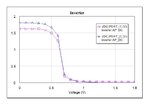cannibol_90
Member level 5
Is it possible to match a 500 KOhm output to a 50 Ohm load over a broad frequency range of 0.5 - 7 GHz?
Follow along with the video below to see how to install our site as a web app on your home screen.
Note: This feature may not be available in some browsers.


I had posted this problem earlier in the following post: Adaptation of a 50Ω Port to a CMOS Ring Oscillator in AWR AO.

